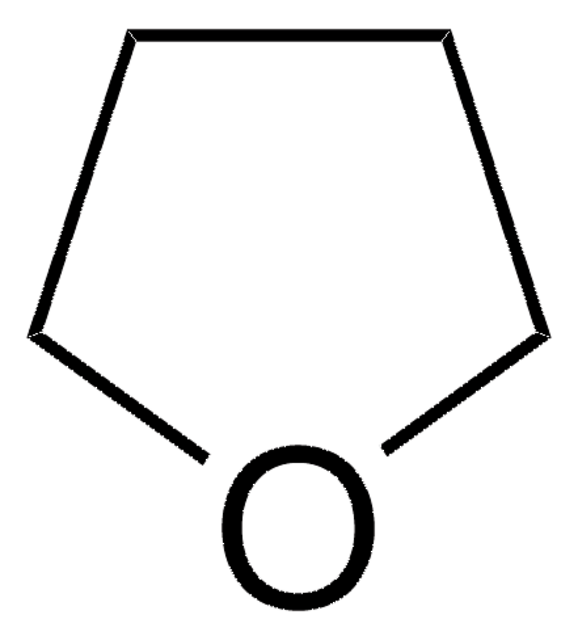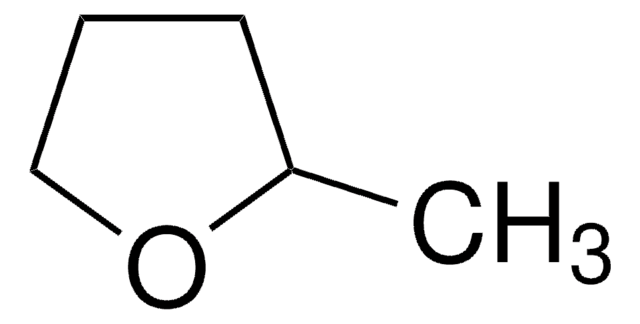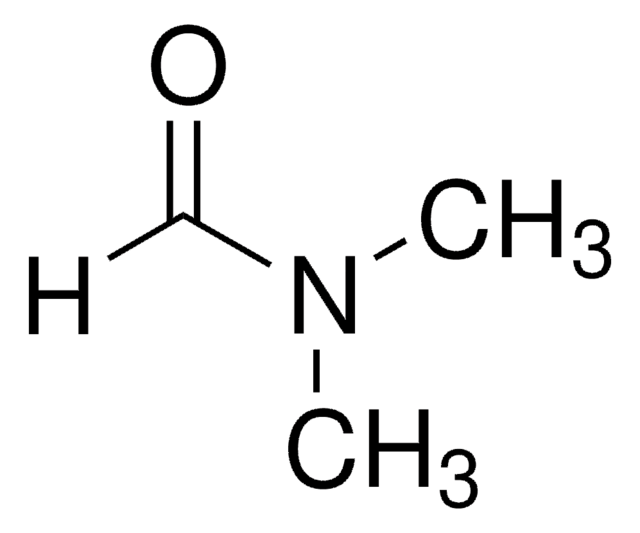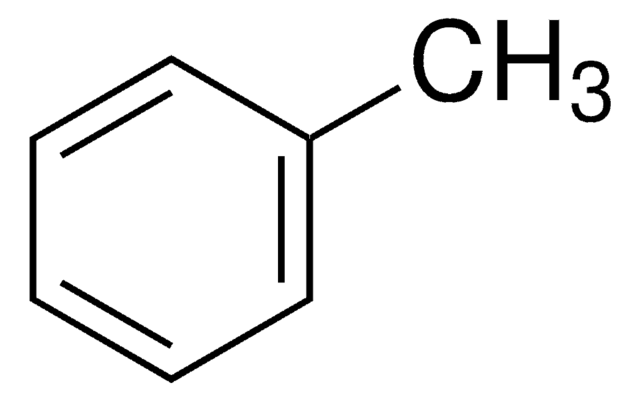186562
Tetrahydrofuran
anhydrous, contains 250 ppm BHT as inhibitor, ≥99.9%
Recommended Products
grade
anhydrous
Quality Level
vapor density
2.5 (vs air)
vapor pressure
114 mmHg ( 15 °C)
143 mmHg ( 20 °C)
Assay
≥99.9%
form
liquid
autoignition temp.
610 °F
contains
250 ppm BHT as inhibitor
expl. lim.
1.8-11.8 %
impurities
≤0.005% peroxides (as H2O2)
<0.002% water (All units except 100 mL)
<0.005% water (100 mL pkg)
refractive index
n20/D 1.407 (lit.)
pH
~7
bp
65-67 °C (lit.)
mp
−108 °C (lit.)
solubility
H2O: soluble
density
0.889 g/mL at 25 °C (lit.)
SMILES string
C1CCOC1
InChI
1S/C4H8O/c1-2-4-5-3-1/h1-4H2
InChI key
WYURNTSHIVDZCO-UHFFFAOYSA-N
Looking for similar products? Visit Product Comparison Guide
Related Categories
General description
Application
Packaging
also commonly purchased with this product
recommended
related product
suggested gloves for splash protection
Signal Word
Danger
Hazard Statements
Precautionary Statements
Hazard Classifications
Acute Tox. 4 Oral - Carc. 2 - Eye Irrit. 2 - Flam. Liq. 2
Supplementary Hazards
Storage Class Code
3 - Flammable liquids
WGK
WGK 1
Flash Point(F)
-6.2 °F - closed cup
Flash Point(C)
-21.2 °C - closed cup
Personal Protective Equipment
Regulatory Information
Certificates of Analysis (COA)
Search for Certificates of Analysis (COA) by entering the products Lot/Batch Number. Lot and Batch Numbers can be found on a product’s label following the words ‘Lot’ or ‘Batch’.
Already Own This Product?
Documents related to the products that you have purchased in the past have been gathered in the Document Library for your convenience.
Difficulty Finding Your Product Or Lot/Batch Number?
How to Find the Product Number
Product numbers are combined with Pack Sizes/Quantity when displayed on the website (example: T1503-25G). Please make sure you enter ONLY the product number in the Product Number field (example: T1503).
Example:
Additional examples:
705578-5MG-PW
PL860-CGA/SHF-1EA
MMYOMAG-74K-13
1000309185
enter as 1.000309185)
Having trouble? Feel free to contact Technical Service for assistance.
How to Find a Lot/Batch Number for COA
Lot and Batch Numbers can be found on a product's label following the words 'Lot' or 'Batch'.
Aldrich Products
For a lot number such as TO09019TO, enter it as 09019TO (without the first two letters 'TO').
For a lot number with a filling-code such as 05427ES-021, enter it as 05427ES (without the filling-code '-021').
For a lot number with a filling-code such as STBB0728K9, enter it as STBB0728 without the filling-code 'K9'.
Not Finding What You Are Looking For?
In some cases, a COA may not be available online. If your search was unable to find the COA you can request one.
Which document(s) contains shelf-life or expiration date information for a given product?
If available for a given product, the recommended re-test date or the expiration date can be found on the Certificate of Analysis.
How do I get lot-specific information or a Certificate of Analysis?
The lot specific COA document can be found by entering the lot number above under the "Documents" section.
Who do I contact about larger solvent volume needs?
Email us at labessentials@sial.com or visit Sigma-Aldrich Fine Chemicals for development and manufacturing-scale inquiries: safcglobal@sial.com
How do I know what packaging options are available for a solvent?
The Solvent Center gives you the ability to review all the specifications associated with our solvent packaging. This includes physical dimensions, closure types, dispensing methods, UN/DOT Rating as well as solvent compatibility. Visit the Solvent Center.
Who do I contact if I need a solvent blend, which you do not carry?
Email us at labessentials@sial.com. For a complete listing of all our Solvent blends, Visit the Solvent Center
The dispensing of solvents provides some challenges due to the number of container options available. What dispensing options are available for each container?
The Sigma-Aldrich Solvent Center provides numerous dispensing options for each container type. For a complete listing of all our dispensing options, Visit the Solvent Center.
Which solvent grade should I be using for my application?
Sigma-Aldrich Solvent Applications Table gives a guideline to common applications and the appropriate solvent grades. Visit: Solvents
What are the options for drying solvents?
Sigma-Aldrich offers a full range of high-purity solvents with extremely low water levels specifically manufactured for moisture sensitive Organic and Biotech applications. Sigma-Aldrich also carries various drying agents such as molecular sieves, which are typically compatible with organic solvents.
What apparatus do you recommend for HPLC solvent filtration?
The Sigma-Aldrich Vacuum Filtration Assembly gives you all the components you need including: funnel top, fritted glass funnel support, filtration flask, aluminum clamp, and silicone stopper. The Acrodisc Syringe Filters offer high quality filtration for analytical samples, certified for HPLC to ensure low extractable and available in a broad range of membranes to meet sample compatibility requirements.
Can you recommend a Solvent Extractor for organics from aqueous solution?
Solvent extractors are often used for the quantitative extraction of organics from aqueous solutions and separations in immunoassays. The MIXXOR system has been applied successfully in many laboratory solvent extraction operations and is ideal for the rapid screening of alternative solvents for specific extraction problems.
Why do peroxides form in certain solvents and how do I test for it?
A significant number of laboratory solvents can undergo autoxidation under normal storage conditions to form unstable and potentially dangerous peroxide by-products. Molecular structure is the primary factor relating to a material’s potential for hazardous peroxide formation. It is important to understand the stability of materials in use and if unclear, consult Sigma-Aldrich Technical Support, techserv@sial.com
What are some of the preservatives used in the most common ethers and chlorinated solvents and why are they added?
Certain solvents will degrade over time requiring special handling and storage considerations. In addition, the products of certain degradation processes pose a potential safety risk if present at sufficiently high levels. For these types of materials, small amounts of stabilizing chemicals are added to slow down or stop material degradation.
How do I find price and availability?
There are several ways to find pricing and availability for our products. Once you log onto our website, you will find the price and availability displayed on the product detail page. You can contact any of our Customer Sales and Service offices to receive a quote. USA customers: 1-800-325-3010 or view local office numbers.
What is the Department of Transportation shipping information for this product?
Transportation information can be found in Section 14 of the product's (M)SDS.To access the shipping information for this material, use the link on the product detail page for the product.
My question is not addressed here, how can I contact Technical Service for assistance?
Ask a Scientist here.
Articles
Research and development of solid-state lithium fast-ion conductors is crucial because they can be potentially used as solid electrolytes in all-solid-state batteries, which may solve the safety and energy-density related issues of conventional lithium-ion batteries that use liquid (farmable organic) electrolytes.
Our team of scientists has experience in all areas of research including Life Science, Material Science, Chemical Synthesis, Chromatography, Analytical and many others.
Contact Technical Service






